Normally we are used to considering a plant above all from what we see: branches, flowers and fruits. Yet, plants do not live like us only on the earth’s surface. They occupy two very different environments at the same time: the overground and the underground.
Maybe you are surprised but for the plants, for the balance and interchange with one’s environment, the under is almost more important than the top. Attilio (prof. Attilio Scienza) uses to say that the roots are the “brain” of the vines. Of course, they are completely different, but it is a useful metaphor to understand their very important function.
… Wanna live underground … as a great legend, David Bowie, sang in a film of my adolescence (Labirinth).
However, it is not easy to study the roots in their underground world. It is not easy to reach them and subject them to tests, managing to keep them intact in all their subtlest ramifications or without upsetting local balances. For this reason, there are not many studies on them or, at least, not as many as they do on the aerial parts. So, there are still many open questions which will require further research, but we have learned something and here I am giving you a brief overview.
As we all know, the roots of the vine serve for the absorption of water and nutrients (the mineral salts of the soil). However, they are also essential for the balance and general well-being of the plant organism because they are mainly responsible of its ability to resist stress.
Animals can react to any environmental stress simply by moving around, as well as looking for food. Plants (as a rule) do not move and have therefore developed enormous adaptability and resistance to the stresses they can undergo during their sedentary life. Their reaction is essentially based on changing the way, speed and direction in which they grow. The signals are not transmitted by the electrical impulses of a neural network, as for animals, but are chemical. We are talking about hormones, that is substances that move around the plant, carrying with them a message to be transmitted. It is the roots that produce a large part of these hormones, which regulate the growth and physiological responses of the entire plant to the external environment.
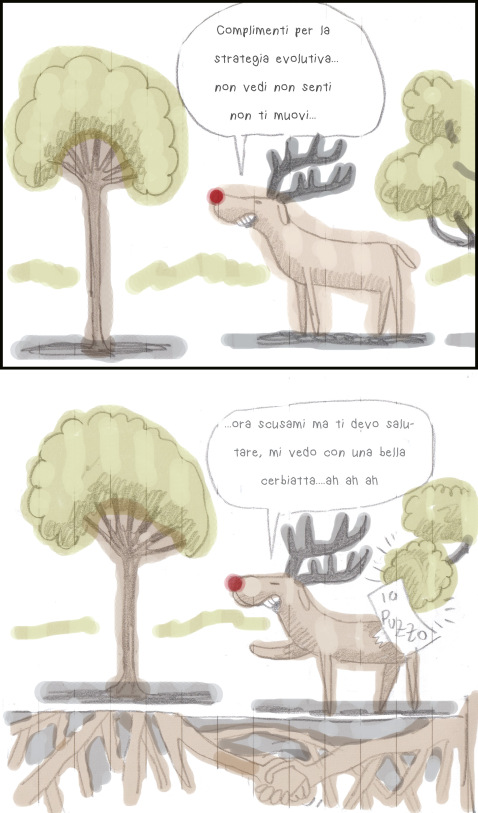
The natural environment of the vine is the Mediterranean one, which can also be very limiting. Since it is an arid or semi-arid climate, it has important limits related to the availability of water. In addition, frequently, it has low organic matter content in the soil. There may also be accumulations of limestone, salt, etc. The roots of the vine have evolved to survive in this difficult environment. They are able to respond well to water stress, to nutritional deficiencies, as well as to survive complex situations. This happens thanks to their ability to expand and renew themselves continuously, to store reserve substances, to enter into symbiosis with other inhabitants of the earth.
According to scholars, the knowledge and the optimal care of the root system is therefore one of the most important issues for the quality of wine. Furthermore, since the vine’s response to stress lies in the roots, this knowledge can offer us great opportunities for optimizing viticulture in relation to climate change. So, let’s see the reason for this importance and how it reflects on the work choices in the vineyard.
As this is a popular article, I have neglected the bibliographic references in the text. However, for those wishing to learn more, my main source is “Vine roots” by South African professors E. Archer and D. Saayman (2018, The Institute for Grape and Wine Sciences, Stellenbosch University), as well as several illustrations. This is an excellent overview. The University of Stellenbosch is considered to be the world’s most qualified center on wine-growing soil studies.
Root structure
Without going into too much detail, I give you some general information.
A vine root is externally wrapped in a protective layer, a more or less thick epidermis which, in the larger and structural roots, is lignified (the cortex). The central part, wrapped in a second protective tissue (the endodermis) includes the most delicate tissues, including those with growth capacity (the pericycle) and which are responsible for transport in the plants, xylem and phloem. The xylem brings what comes from the roots to the whole plant: the water, the nutrients, the substances they produce (hormones and others). It is made of hollow tubes and the transport takes place by capillary flow, mainly driven by the leaf transpiration. The phloem mainly has a reverse path: it carries the products of photosynthesis from the leaves to the rest of the plant. It is made up of living cells, which actively move these products through them. These essential parts can be structured differently according to the different types of roots, depending on their role, the genetics of each rootstock, …
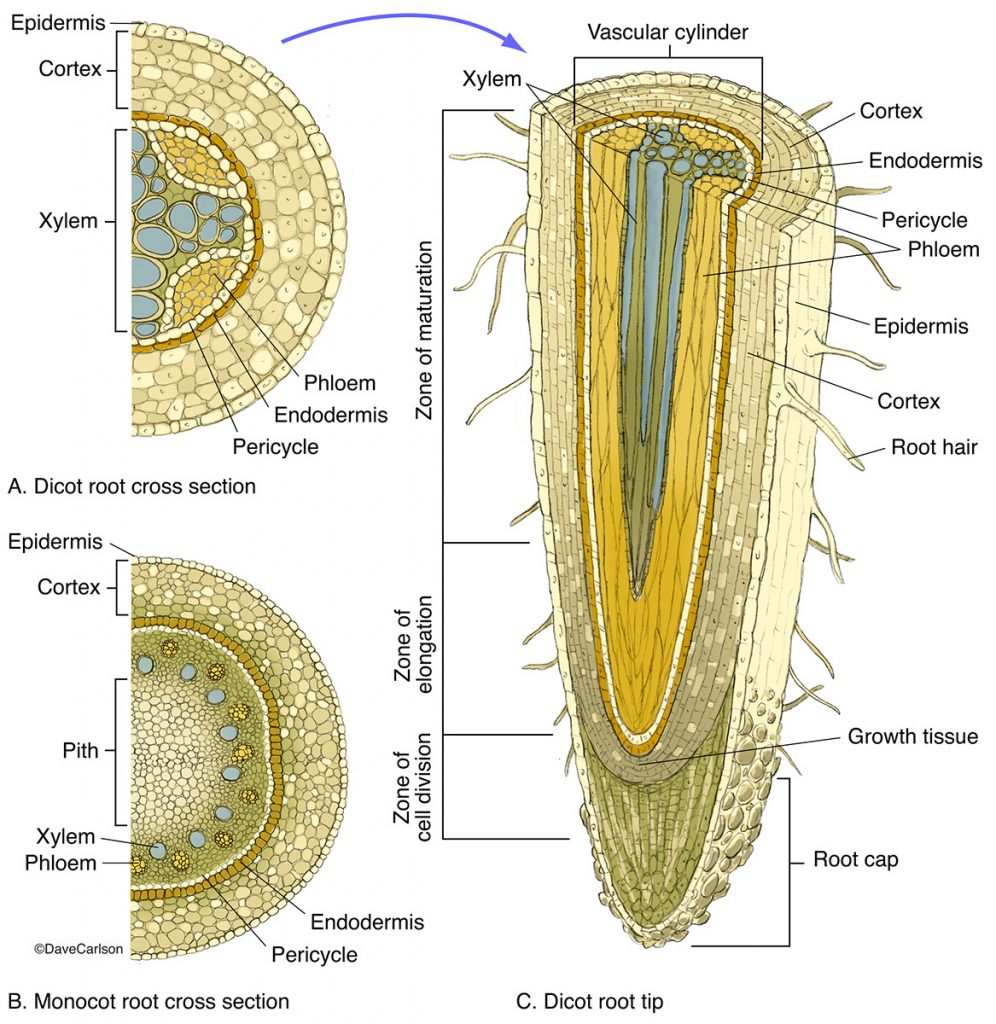
In fact, the are different types of roots. Those called primary, or even structural or tap root, are the thickest (6-10 mm). They are lignified and have the role of anchoring the plant to the ground. In addition, they are an important crossroads for the transport of nutrients and water. Finally, they are storage centers of the plant’s reserves. The secondary roots are the thinnest ones (2-6mm). They stretch both laterally and in depth. The more superficial ones are very important especially for the absorption of mineral nutrients, which are mainly found in the upper layers of the soil. They are also useful for absorbing water, intercepting it before it flows away or goes down. The depthest are instead essential to resist water stress. Further branches start from these roots, the fibrous or absorbent roots. These live for just one season and are continually renewed. They are the most extreme offshoot of the plant, the main ones responsible for the absorption of nutrients and water. The contact surface with the soil is even more extended by the root hairs, as well as by the hyphae of the fungi in symbiosis with the roots.
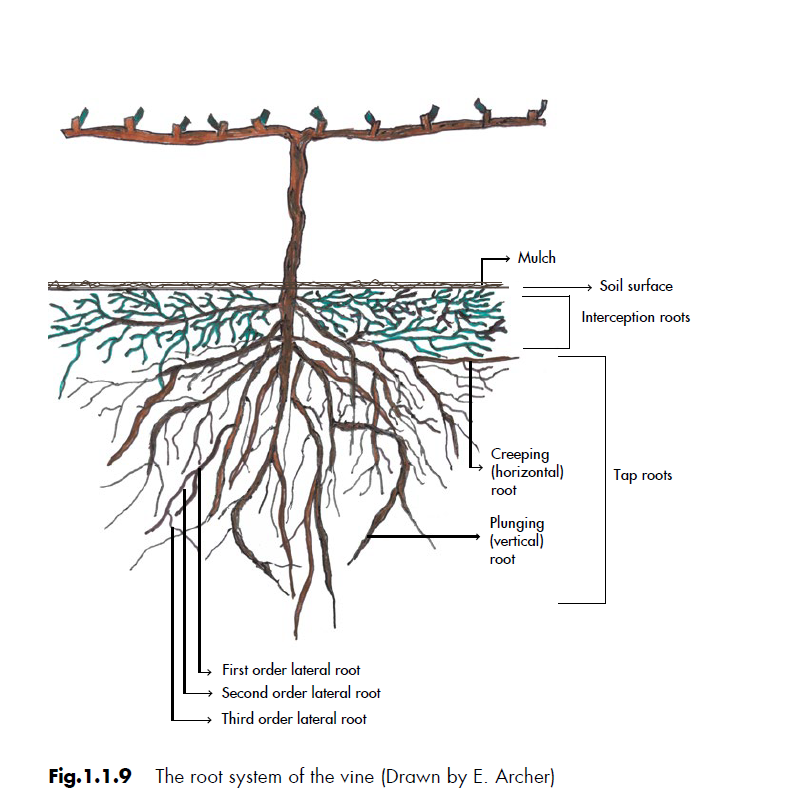
People often talk about the lenghts of the roots of the vine. However, the exchange capacity with the soil depends above all on their branching and, therefore, on the soil space they manage to occupy in density. The more the vine is in favorable soil conditions, the more it tends to branch and the more it optimizes its exchange capacity. It is possible to have 200 meters of root for every cubic meter of soil (about 1.0-1.5 kg of roots per cubic meter). Conversely, in the most unfavorable conditions, the roots are inhibited both in elongation and in branching. In this case, there is a wider mesh and the plant has less vigor. If the root density and distribution are very limited, an imbalance is created between the vegetative growth and the grape production which leads to poor grapes and wines of lower quality, especially in the driest years.
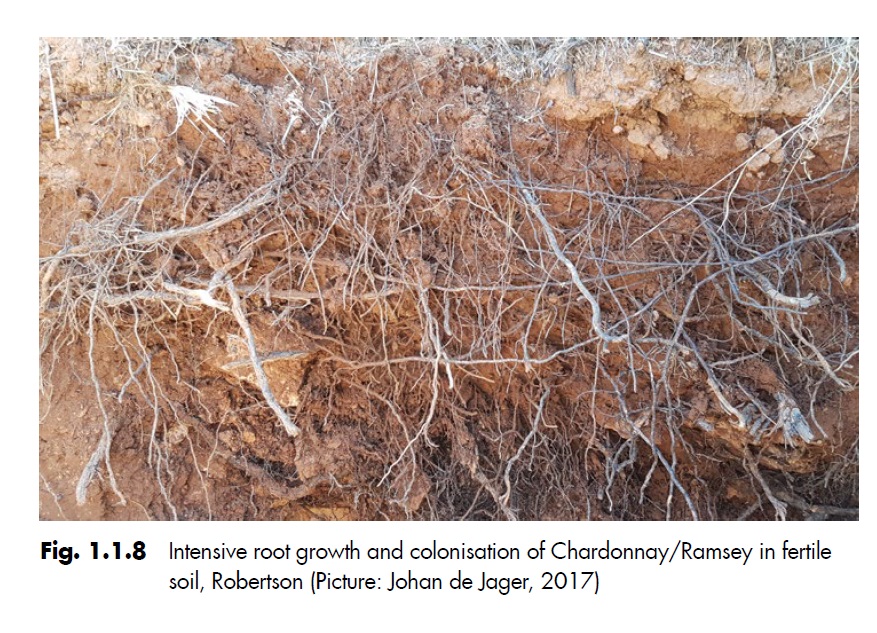
Thicker roots don’t die easily. Instead, the finer roots die continuously and are replaced within a few weeks. This continuous restoration, together with the abrasion that the outermost tissue of the living roots undergoes, consistently enriches the soil with organic matter. Champagnol (1984) quantified this contribution up to 8 tons per hectare per year, for the entire life of the vineyard.
The relationship with mycorrhizae and other inhabitants of the rhizosphere
The roots are not isolated but “communicate” with their environment and the other inhabitants of the soil. They produce a mucus towards the outside, a gelatinous substance that has many functions, not all of which have been clarified, including that of limiting damage from abrasion by soil particles. This gel contains carbohydrates, amino acids, organic acids, enzymes and other compounds. Some of these substances are used as food by a wide range of organisms living in the soil. It has been seen that some also have a stimulating or vice versa blocking action on the growth of fungi, bacteria or nematodes. Furthermore, as already mentioned, the roots also annually produce a large mass of organic material, which is an ideal humus for various organisms of the rhizosphere.
One of the best known relationships that the vine establishes with other soil organisms is that with mycorrhizae. The name means “root fungus”. They are in fact fungi that live in symbiosis with the roots of different plants, some outside and others also inside the root tissues. They are in symbiosis, that is, there is a reciprocal and not harmful exchange between the two organisms. Fungi mainly take the carbohydrates produced by the plant, while helping the vine in the absorption of water and nutrients from the soil. The mycorrhizae can consume up to 4-20% of the photosynthetic production of the plant. At first they have a negative effect, until an optimal balance is established.
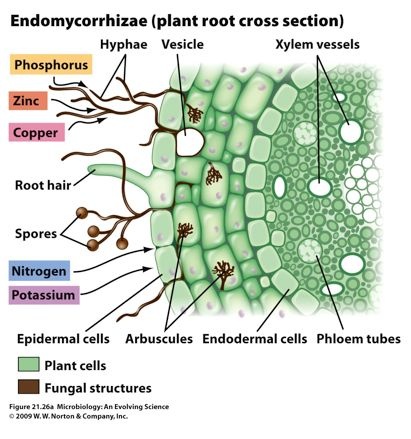
The fungus optimizes the absorption of the plant because its hyphae are long (20 mm hips) and much thinner than the roots, which are up to 500 or 1000 times thicker. They are therefore able to penetrate the pores between the soil particles where the roots cannot reach. Their presence increases the absorption capacity for the plant of water and of some mineral elements (such as phosphates or iron). They have also been seen that they can increase the plant resistance to salinity, to heavy metals such as copper, as well as the resistance to some diseases and other adversities. Their action is also hypothesized in the hormonal regulation of the vine, but these aspects are still being studied. However, the root colonization by these fungi does not always occur: it is conditioned by numerous factors, above all by the characteristics of the soil. Their presence, for example, changes with the pH: they decrease in more acidic soils. They are absent in very dry, saline or stagnant soils, with too high or, conversely, too low fertility.
On the basis of these studies, there are those who propose the artificial inoculation of mycorrhizae in the soils of the vineyards. According to experts, this practice is of little use. It has in fact been seen that if the soil conditions are adequate, the mycorrhizae colonize the vines very easily in a natural way. If the soil conditions are unfavorable, the inoculated mycorrhizae would die anyway. The presence of these fungi is therefore an intrinsic advantage of the best soils for viticulture. We can try to optimize it with adequate soil care and agroecological practices (see here), but only if the conditions are favorable to their presence.
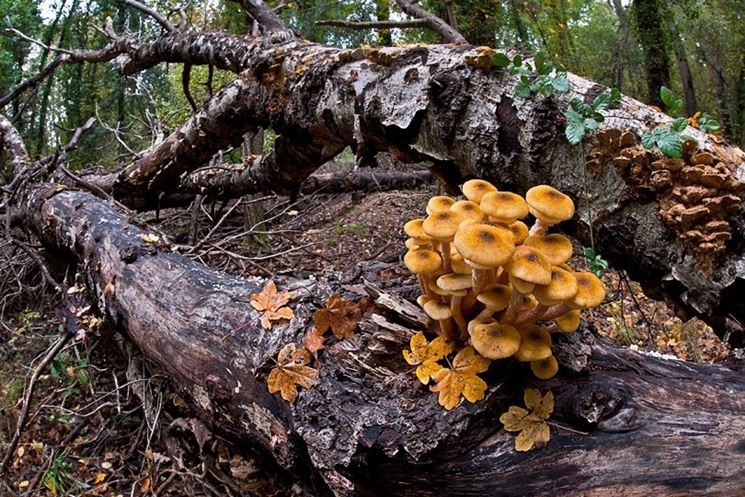
In the soil there are also organisms that can attack roots with dramatic effects. Some are better known, others less, again due to the intrinsic difficulty of studying the soil life. Beyond the well-known phylloxera (defeated in the past thanks to the use of resistant rootstocks), there are also other insects (beetles, nematodes, hemiptera larvae) which, directly or as virus vectors, can cause the weakening of the vines , sometimes until the plant dies. There are also numerous fungi that cause root rot, such as some species of the genera Phytophthora, Pythium, Armillaria, etc. It seems that even the infamous esca disease, which causes the death of many vines in the vineyards, is linked to soil fungi. Unfortunately, as experience has already taught us with the phylloxera, while it is relatively simple to study and combat a pathogen that attacks the aerial part of the vine, it becomes much more complicated if it happens in the soil. Our best answers, for now, come from the prevention of the spread of infections with controls in the nurseries, in the search for genetic resistance and in the care of the vineyard soil.
Where the roots develop
The winemakers often tell, poetically, that the roots descend into the depths of the earth even for tens of meters. This is partly true: the vine is one of the woody plants whose roots go deeper, but it is also true that there are hardly such deep soils (underneath there is the bedrock, impenetrable by the roots).
In any case, it has been seen that the roots tend to develop and occupy mainly the soil spaces where they find the best conditions in relation to water, temperature and air. On average, without other limitations, they prefer humid but not stagnant areas (where they would die of asphyxiation), warm and airy.
The direction of root growth is driven by two main forces: the search for water (hydrotropism) and mineral nutrients (chemotropism). The more superficial the aquifer is, the more the roots will stay on the surface. The root of the vine senses the depth at which it is located and changes its preferential direction of growth. It has been seen that the more superficial roots tend to grow downwards. Those deeper, if they can, prefer to expand laterally, because they do not like the deeper asphyxiating layers. The more deeper roots, if they can, tend to grow upward. Over time and the appropriate conditions are in place, all the roots tend to stabilize at the same optimal level, which can be variable but still relatively close to the surface: it is not too superficial (due to the risk of drying), it is not too deep (due to the risk of asphyxiation).
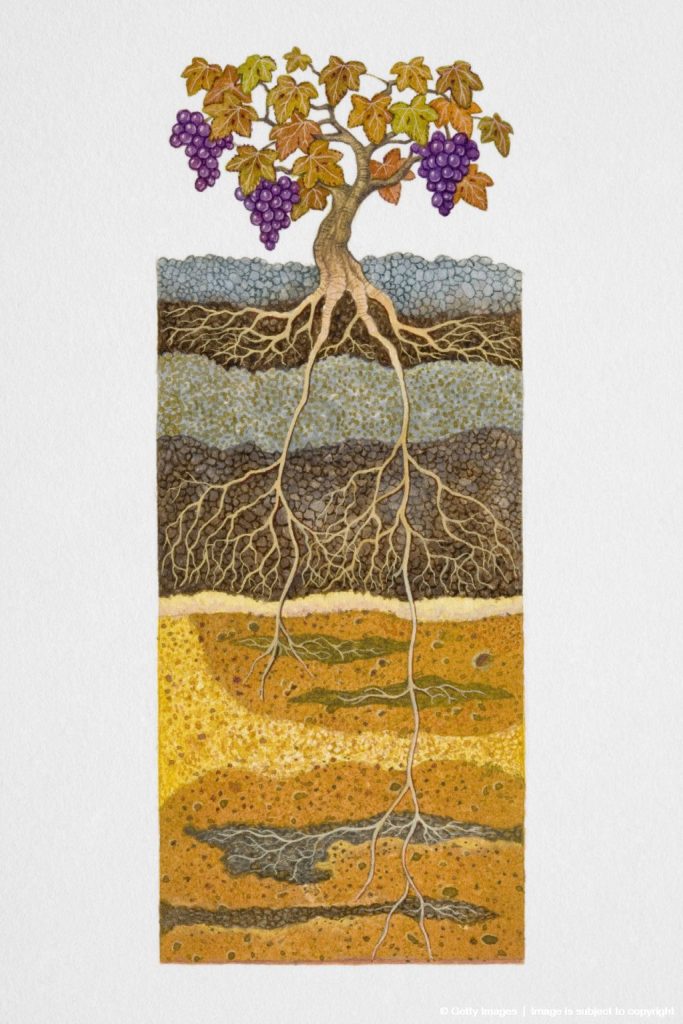
The element that most conditions the natural propensity for growth of the vine root is the physical structure of the soil. The differences in the soils considerably affect the ability to form an optimal root system, with important and proven effects on plant growth and on the characteristics of grapes and wine. Above all, they greatly affect the plant’s need to have enough water available during growth times.
The depth of the soil is one of the most important elements in viticulture, because it guarantees the full development of the root system. The shallow soils are limiting: the root can expand little, it may not be able to reach groundwater or areas rich in minerals. The other key element is its softness. The more compact the soil, the more growth slows and the branching of the root is reduced, until it can become a real impenetrable barrier. The roots only advance if the pore size is adequate or if there are cracks or other pathways. For example, they grow well in spaces left by previous dead roots, in passages dug by the earthworms, etc. Instead, they block when they encounter hard layers, such as compact clayey areas or iron concretions. When they encounter an unfavorable area, they tend to branch out on and around it. The texture of the soil changes the penetration capacity and root density. The sandy soils on average determine a greater elongation but lower root density. A medium texture (silty), decreases the penetration but determines a greater density. The fine soils (clayey), on the other hand, reduce the penetration even more, while the density does not vary that much. Each of these characteristics may or may not be an advantage depending on your environment, the availability of water or the grapevines varieties. In a heterogeneous soil, the roots will be distributed differently depending on the nature of the layers, more or less favorable to root expansion.
The chemistry of the soil, on the other hand, seems a little less important, if not for a different sensitivity to the pH that the different rootstocks show. Below 5 is a bit limiting for everyone. The number of fine roots is positively influenced by the fertility of the soil, even if the vine has an accentuated chemotropism, so it can grow well even in poor soils.
Soil is the most decisive element. The genetics of the rootstock seems to affect mainly the root density. The rootstocks most resistant to drought are those that have the greatest density and distribution of roots. Those with smaller and thinner roots are instead the most exposed to the risk of drought.
Therefore, in a Mediterranean climate, with deep soil, the main mass of the roots is concentrated on average in the range between 25 and 55 cm in depth. This area can vary in relation to several factors. The climate, for example, is important: where it is cooler they tend to stay a little more on the surface, deeper where it is warmer.
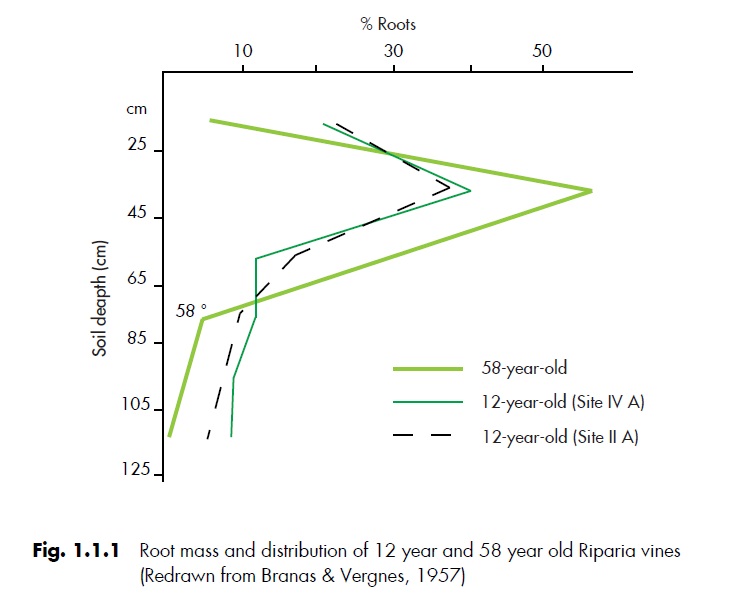
The most superficial part of the soil, above 25 cm, generally has fewer roots for several reasons. This is an area that can be too dry. In addition, in this band the work of the winemakers insist, which has a destructive effect. In addition, they also suffer competition with any cover vegetable species.
The deeper layers are also the least interested by the root mass. It is true that the roots can go down to great depths, if the soil is deep enough or leaves passage spaces. In this capacity lies the great resistance to water stress of the vine. However, we are talking about a minority part, because they are situations in any case at the limit as the roots are sensitive to the lack of air (under 10%, they die in a short time). There is, however, a different ability of rootstocks to resist radical asphyxiation.
To search for water, the roots preferably expand laterally, if they can, even for several meters. They also freely overlap with those of the neighboring vines, even if 80% is concentrated in the space of the single plant. The overlapping, however, has the effect of decreasing the vigor, as can be easily seen from the fact that the first grapevines of the row are always the most vigorous.
How the roots grow in the different stages of the plant’s life and throughout the year
The roots grow more or less in relation to environmental conditions, the age of the plants and the activity of the canopy (the part of the leaves).
When the vine is young, the roots develop a lot and branch proportionally to the development of the canopy (if this is not pruned). This phase, which lasts about 7-8 years, is very important because it is the one of maximum elasticity. In this period the roots of the vines adapt to the local climate and soil conditions. After this stage, they will not be able to change their adaptation. In adulthood, the average elongation is increasingly scarce: the size of the root tends to stabilize, as does the vigor of the canopy. During the aging phase, the vine reaches its maximum complexity, but the plants can also suffer from the damage caused over the years by parasites and other adversities. The studies shown in the diagram above, which compared adult (12 years) and very old (50 years) vines, show that the old vine has a larger root mass, but is located more or less in the same area as that adult. However, the deeper roots are reduced. It seems that the strength of an old vine can be compromised more by damage to the trunk and the aerial part than to the roots themselves, which are generally very resistant.
Every year, more or less rapidly depending on the age, the roots grow and, above all, renew the thinner and more absorbent parts. This growth does not happen all the time, but at particular moments. It has been seen that root growth occurs when the plant has an excellent availability of the products of photosynthesis. This growth does not start immediately with budding, but after a few weeks. For colder climates, it can start even 10 weeks later. After that, there are peaks and slowdowns that vary with the climate. Broadly speaking, two main behaviors have been identified:
- in the warmer regions, in the Mediterranean ones and especially in the southern hemisphere, there are two peaks, one during flowering, when the growth of buds slows down, and a second smaller after the harvest.
- in regions with a more moderate climate, growth is slower and more continuous and reaches a peak in late summer or at harvest. If the leaves remain active after the harvest, the growth continues for several weeks.
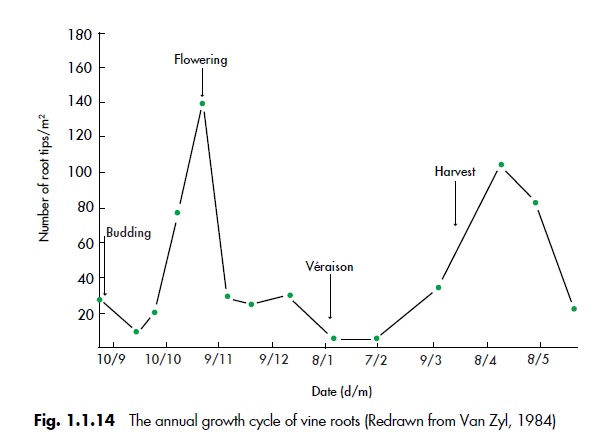
In autumn and especially in winter, many roots die, especially the thinner ones, due to frost, rot, damage caused by various parasites, etc. Furthermore, as the water table rises, part of the root system can go under water and die of asphyxiation. Immersion can only be endured by the largest and permanent roots, when they are in the dormancy phase and all processes are limited. Many new thin and absorbent roots will be reformed over the next spring, as already explained.
Continued …